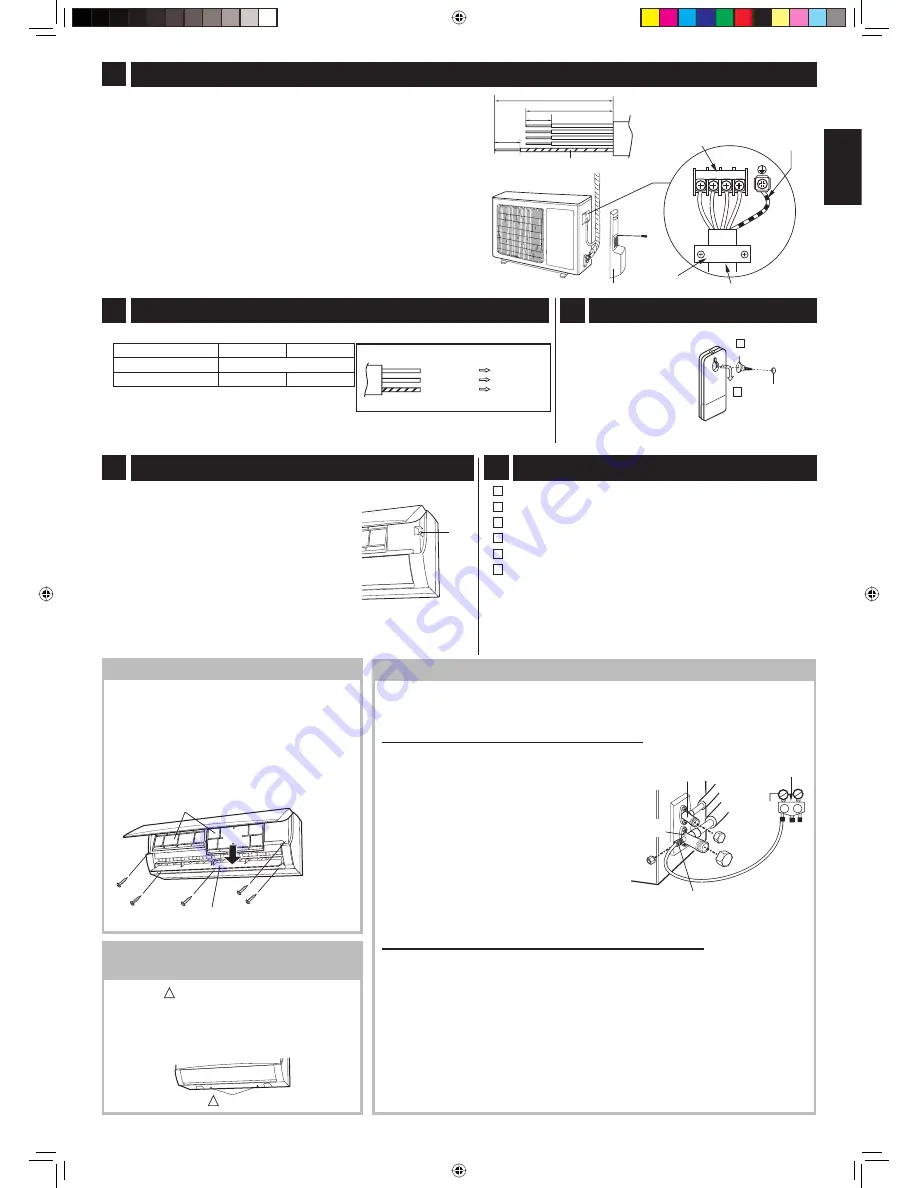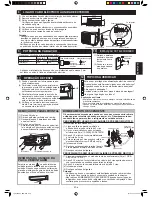
ENGLISH
GB-4
8 mm
8 mm
40 mm
50 mm
2
N
(1)
4 5
Lo
Hi
(3)
(2)
(1)
DETACHING THE UNIT FROM
THE MOUNTING PLATE
Push the “ “ marks at the bottom of the
indoor unit and pull the bottom of the unit.
When the hooks are released from the mount-
ing plate, support the bottom of the unit and
lift the unit upwards.
(1) Process the end of the connecting cable for the outdoor unit.
(2) Remove the control box cover.
(3) Remove the cable holder and connect the cable.
Be sure that the terminal connections are as speci
fi
ed.
(4) Fix the cable sheath with the cable holder and the screw.
(5) Double-check that the cable is securely in place.
(6) Put back the control box cover.
Caution:
• Be sure to put the cable leads deep into the terminal board and
tighten up the screws. Poor contact can cause overheating or
fi
re, or malfunction.
• Be sure to connect the cable to match the markings on the out-
door unit’s terminal board and those of the indoor unit.
Earth wire
Control box cover
Connecting cable
Terminal board
Cable holder
Screw
Power supply cable
Blue
Brown
Green/Yel-
low-striped
Power supply
Neutral
Live
Ground
AUX
Prepare a dedicated power supply circuit.
AY-AP9NR
AY-AP12NR
Supply power
220 V - 240 V, single-phase
Circuit breaker
10 A
15 A
8 CONNECTING THE CABLE TO THE OUTDOOR UNIT
9 POWER CABLING
11 TEST RUN
(1) Start the operation with the remote control.
(2) To start test run in cooling, hold down the
AUX button on the unit for over 5 seconds
until a beep sound is heard and an opera-
tion lamp
fl
ashes.
(3) To put the system in the heating test run
mode, select heat mode on the remote
control while the unit is in cooling test run
mode.
(4) Make sure the system runs well. To stop
the operation, press the AUX button again.
12 ITEMS TO CHECK
Is the speci
fi
ed power supply voltage used?
Is the connecting cable
fi
xed to terminal board
fi
rmly?
Is the earth wire connected properly arranged?
Is the drainage properly?
Is the indoor unit hooked to the mounting plate
fi
rmly?
Is there any gas leakage at the pipe connection?
Explanation to customer
• Explain to the customer how to use and maintain the system, refer-
ring to the operation manual.
• Ask the customer to carefully read the operation manual.
• When the system has been set up, hand the installation manual to
the customer.
• Fit a disconnect switch, having a contact separation of at least 3mm in all
poles, to the electricity power line.
Earth wire
“
“ mark
10 HANGING THE REMOTE CONTROL
DETACHING THE FRONT PANEL
(1) Remove the air
fi
lter.
(2) Open the vertical air
fl
ow louvre by hand.
(3) Unscrew the 5 screws of the front panel.
(4) Remove the front panel.
Slightly open the lower part of the front
panel, and extract the 5 hooks along the
upper surface for disassembly.
Screw
Vertical air
fl
ow louvre
Air
fi
lter
(1) Fit the special
screw to the wall
with the wall plug.
(2) Hang the remote
control to the screw
head.
6
SPECIAL
SCREW
2
WALL PLUG
PUMP DOWN
Pump down is adopted in the case of unit removal for re-installation,
abandonment, repair etc. Pump down is to collect the refrigerant into the
outdoor unit.
PROCEDURE USING GAUGE MANIFOLD
(Recommended procedure)
(1) Connect the gauge manifold hose to the
service port of the 3-way valve.
(2) Run the air conditioner at cooling test run
mode (Refer to 11 TEST RUN).
(3) After 5-10 minutes, close the 2-way
valve.
(4) Close the 3-way valve when the com-
pound gauge reading becomes almost 0
MPa(0 cmHg).
(5) Stop the test run operation.
(6) Disconnect the gauge manifold hose
from the service port.
(7) Disconnect both refrigerant pipes.
PROCEDURE WITHOUT USING GAUGE MANIFOLD
(1) Run the air conditioner at cooling test run mode (Refer to 11 TEST RUN).
(2) After 5-10 minutes, fully close the 2-way valve by turning the hexagon
wrench.
(3) After 2-3 minutes, immediately close the 3-way valve fully.
(4) Stop the test run operation.
(5) Disconnect both refrigerant pipes.
Caution:
• Make sure that the compressor is turned off before removing the refrigerant
pipes. Otherwise, it will cause burst and injury.
• Do not perform PUMP DOWN when refrigerant is leaking or there is no refrig-
erant in the refrigerant cycle. Otherwise, it will cause burst and injury
Gauge manifold
Compound
gauge
3-way valve
2-way valve
Service port
04_A3AYAP9_2NR.indb GB-4
04_A3AYAP9_2NR.indb GB-4
2012-01-12 20:45:12
2012-01-12 20:45:12






































